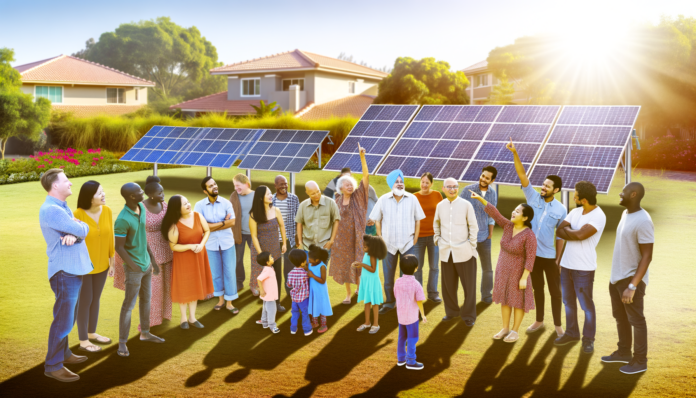Introduction to Community Solar Projects
What is a Community Solar Project?
A community solar project is a solar power installation that allows multiple participants to benefit from the electricity generated by one or more solar arrays. Unlike traditional solar systems that are installed on individual rooftops, community solar projects are typically located on a shared site, such as a large field or a commercial rooftop. Participants, who can be homeowners, renters, or businesses, subscribe to a portion of the solar energy produced and receive credits on their electricity bills for their share of the power generated.
Benefits of Community Solar
Community solar projects offer a range of benefits that make them an attractive option for many:
- Accessibility: They provide access to solar energy for those who cannot install solar panels on their own property due to financial constraints, roof conditions, or because they rent their homes.
- Cost Savings: Participants can save money on their electricity bills, as solar power is often cheaper than electricity generated from fossil fuels.
- Environmental Impact: By using renewable energy, community solar projects help reduce greenhouse gas emissions and reliance on fossil fuels.
- Resilience: These projects can enhance community resilience by providing a reliable source of power during blackouts or extreme weather events.
- Economic Development: They can stimulate local economies by creating jobs in the solar industry and generating community wealth.
Why Community Solar is Gaining Popularity
Community solar is rapidly gaining popularity for several reasons:
- Inclusive Energy Solutions: Nearly 50% of households and businesses are unable to host rooftop solar systems. Community solar provides an inclusive solution that allows a broader range of people to participate in and benefit from solar energy.
- Legislative Support: Many states have passed enabling legislation that encourages or mandates community solar projects. This legislative support has led to an increase in the number of projects and available subscriptions.
- Consumer Protections: Well-designed community solar programs incorporate key consumer protections, ensuring that subscribers receive tangible benefits such as bill credits and energy savings without hidden fees or complicated contracts.
- Technological Advancements: Advances in solar technology and project management have made community solar projects more efficient and cost-effective, further driving their adoption.
- Environmental Awareness: As awareness of climate change and environmental issues grows, more communities are seeking sustainable energy solutions. Community solar projects offer a practical way to reduce carbon footprints and promote environmental stewardship.
In summary, community solar projects are an innovative and inclusive way to harness the power of the sun, providing significant economic, environmental, and social benefits. As more people and communities recognize these advantages, the popularity and implementation of community solar projects are expected to continue to rise.
Understanding the Basics
How Community Solar Works
Community solar projects, also known as solar gardens or shared solar, allow multiple participants to benefit from a single solar energy system. These projects are typically located off-site and the energy generated is fed into the local grid. Participants, who can be individuals, businesses, or organizations, receive credits on their utility bills for their share of the produced electricity. This model is particularly beneficial for those who cannot install solar panels on their property due to space, cost, or other constraints.
Types of Community Solar Models
Community solar projects generally follow two main models: **subscription-based** and **ownership-based**.
- Subscription-Based Model: In this model, participants subscribe to a portion of the solar energy produced by the community solar farm. They typically pay a monthly fee or a reduced rate for the electricity generated. This model is accessible and low-risk, as subscribers can often join without any upfront costs and cancel their subscription if needed.
- Ownership-Based Model: In this model, participants buy or lease a share of the community solar project. This share represents a portion of the solar panels and the electricity they produce. While this model requires a higher initial investment, it can offer long-term financial benefits and a greater sense of ownership and involvement in the renewable energy project.
Key Stakeholders Involved
Several key stakeholders play crucial roles in the development and operation of community solar projects:
- Utilities: Utilities often sponsor community solar programs, owning, installing, and managing the solar systems. They handle billing and provide credits on participants’ utility bills based on their share of the solar output.
- Third-Party Developers: These can be private or nonprofit entities that own, install, and manage the community solar systems. They bill customers directly for their portion of the solar output, and the utility provides the corresponding credits on the customers’ utility bills.
- State and Local Governments: Governments play a role in enacting enabling legislation, providing regulatory oversight, and sometimes directly subscribing to community solar projects. They also help with permitting processes and may offer incentives to encourage participation.
- Community Members: Individuals, businesses, and organizations that subscribe to or invest in community solar projects. Their participation is essential for the success and sustainability of these projects.
By understanding how community solar works, the different models available, and the key stakeholders involved, communities can better navigate the process of starting and benefiting from a community solar project.
Steps to Start a Community Solar Project
Assessing Community Needs and Interest
Before embarking on a community solar project, it is crucial to gauge the community’s needs and interest. Conduct surveys, hold town hall meetings, and engage with local organizations to understand the level of interest and the specific needs of the community. This initial step helps in identifying potential subscribers and understanding their energy consumption patterns, financial capabilities, and preferences. Engaging the community early ensures that the project is tailored to meet local needs and garners broad support.
Securing Funding and Financial Planning
Securing adequate funding is a critical step in launching a community solar project. Explore various funding options such as grants, loans, and investments from private entities or government programs. Financial planning should include a detailed budget covering all aspects of the project, from initial feasibility studies to construction and ongoing maintenance. Consider the financial models that will be used, such as subscription-based or ownership-based models, and ensure that they are financially viable and attractive to potential subscribers.
Choosing a Suitable Location
Selecting the right location for the solar array is essential for the project’s success. The site should have ample sunlight, be easily accessible for construction and maintenance, and comply with local zoning laws. Consider using underutilized spaces such as brownfields, landfills, or rooftops of large buildings. These locations can offer dual benefits by repurposing otherwise unused land and minimizing environmental impact. Conduct a thorough site assessment to ensure the chosen location meets all technical and regulatory requirements.
Navigating Legal and Regulatory Requirements
Community solar projects must comply with a range of legal and regulatory requirements. These can include zoning laws, building codes, and interconnection standards with the local utility grid. It is essential to work closely with local government agencies and legal experts to navigate these requirements. Additionally, ensure that the project adheres to consumer protection regulations, especially if targeting low-income households. Understanding and complying with these regulations can prevent legal hurdles and ensure smooth project implementation.
Selecting Technology and Partners
Choosing the right technology and partners is crucial for the project’s long-term success. Select high-quality solar panels, inverters, and other equipment that offer reliability and efficiency. Partner with experienced developers, contractors, and maintenance providers who have a proven track record in community solar projects. Additionally, consider partnering with local organizations and businesses to enhance community engagement and support. The right technology and partners can significantly impact the project’s performance, cost-effectiveness, and community acceptance.
Implementation and Management
Project Planning and Timeline
Effective project planning is crucial for the successful implementation of a community solar project. The planning phase involves setting clear objectives, defining the scope, and establishing a timeline. Key milestones should include feasibility studies, securing permits, and finalizing contracts with stakeholders. A well-structured timeline helps in tracking progress and ensuring that the project stays on schedule. Typically, the planning phase can take anywhere from six months to a year, depending on the complexity and scale of the project.
Construction and Installation
Once the planning phase is complete, the construction and installation phase begins. This involves site preparation, installing solar panels, and connecting the system to the grid. It is essential to hire experienced contractors and engineers to ensure that the installation meets all safety and quality standards. The construction phase can vary in duration but generally takes between three to six months. During this period, regular site inspections and quality checks are necessary to address any issues promptly and keep the project on track.
Operations and Maintenance
After the installation is complete, the focus shifts to operations and maintenance (O&M). Effective O&M ensures the long-term performance and reliability of the solar system. This includes routine inspections, cleaning of solar panels, and timely repairs. A well-maintained system can operate efficiently for 25 years or more. It is advisable to have a dedicated team or hire a professional O&M service provider to handle these tasks. Regular maintenance not only extends the lifespan of the system but also maximizes energy production and financial returns.
Monitoring and Performance Evaluation
Continuous monitoring and performance evaluation are critical for the success of a community solar project. Advanced monitoring systems can track the performance of the solar panels in real-time, providing data on energy production, system efficiency, and potential issues. This data is invaluable for making informed decisions and optimizing the system’s performance. Performance evaluation should be conducted periodically, with detailed reports generated to assess the system’s health and identify areas for improvement. Regular monitoring helps in ensuring that the project meets its energy production goals and provides maximum benefits to the community.
Maximizing Benefits for the Community
Reducing Energy Costs
Community solar projects offer a significant opportunity to reduce energy costs for participants. By pooling resources and investing in a shared solar array, communities can take advantage of economies of scale, which often results in lower installation and maintenance costs per household compared to individual solar systems. **Subscribers to community solar projects typically see a reduction in their monthly electricity bills**, as they receive credits for the energy produced by their share of the solar array. These savings can be particularly impactful for low-income households, helping to alleviate energy poverty and improve financial stability.
Environmental Impact and Sustainability
Community solar projects contribute to environmental sustainability by reducing reliance on fossil fuels and lowering greenhouse gas emissions. **Solar energy is a clean, renewable resource that generates electricity without producing harmful pollutants**. By participating in a community solar project, residents can collectively reduce their carbon footprint and contribute to a healthier environment. Additionally, these projects often include educational components that raise awareness about renewable energy and environmental stewardship, fostering a culture of sustainability within the community.
Educational and Community Engagement Opportunities
Community solar projects provide numerous educational and engagement opportunities. **Schools, local organizations, and community groups can use these projects as real-world examples to teach about renewable energy, climate change, and sustainability**. Workshops, tours, and informational sessions can be organized to educate residents about the benefits of solar energy and how the community solar project operates. Furthermore, these projects can strengthen community bonds by bringing people together to work towards a common goal. Engaging local stakeholders in the planning and implementation process ensures that the project meets the community’s needs and fosters a sense of ownership and pride among participants.
In summary, community solar projects offer a multifaceted array of benefits, from reducing energy costs and promoting environmental sustainability to providing educational and community engagement opportunities. By leveraging these advantages, communities can create a more resilient, informed, and cohesive society.
Challenges and Solutions
Common Challenges in Community Solar Projects
Community solar projects, while beneficial, face several challenges that can hinder their development and success. Some of the most common challenges include:
- Financial Barriers: Securing funding for initial setup and ongoing maintenance can be difficult. High upfront costs and the need for continuous financial support can deter potential investors and participants.
- Regulatory Hurdles: Navigating the complex web of local, state, and federal regulations can be daunting. Different jurisdictions have varying requirements, which can delay project timelines and increase costs.
- Site Selection: Finding a suitable location that meets all technical, environmental, and regulatory criteria can be challenging. Issues such as land availability, zoning laws, and environmental impact assessments must be addressed.
- Community Engagement: Gaining community buy-in and participation is crucial but can be difficult. Misunderstandings about the benefits and operations of community solar can lead to resistance or apathy.
- Technical Challenges: Integrating the solar array with the existing grid, ensuring reliable energy production, and maintaining the technology can pose significant technical challenges.
Strategies to Overcome Challenges
Despite these challenges, there are effective strategies to overcome them and ensure the success of community solar projects:
- Financial Solutions: Explore diverse funding sources such as grants, loans, and public-private partnerships. Offering subscription models that require no upfront costs can also attract more participants.
- Regulatory Navigation: Engage with local authorities early in the planning process to understand and comply with all regulatory requirements. Hiring legal experts who specialize in energy projects can also streamline this process.
- Strategic Site Selection: Conduct thorough site assessments and feasibility studies to identify the best locations. Collaborate with local governments and landowners to secure suitable sites.
- Community Outreach: Implement robust community engagement strategies, including public meetings, educational campaigns, and transparent communication. Highlight the economic, environmental, and social benefits of the project to gain community support.
- Technical Expertise: Partner with experienced solar developers and engineers to address technical challenges. Regular maintenance and performance monitoring can ensure the long-term reliability of the solar array.
Case Studies of Successful Projects
Examining successful community solar projects can provide valuable insights and inspiration:
- Shine Community Solar, Colorado: This project overcame financial barriers by securing a mix of state grants and private investments. They also engaged the community through workshops and local events, resulting in high participation rates.
- Solar for All, New York: This initiative focused on low-income households, offering no-cost subscriptions and guaranteed savings on energy bills. By partnering with local non-profits and government agencies, they navigated regulatory challenges and ensured community buy-in.
- SunShare, Minnesota: SunShare successfully integrated their solar arrays with the local grid by collaborating closely with utility companies. They also conducted extensive site assessments to select optimal locations, ensuring efficient energy production and minimal environmental impact.
By learning from these examples and implementing strategic solutions, communities can overcome the challenges associated with community solar projects and reap their numerous benefits.
Future of Community Solar
Emerging Trends and Innovations
The landscape of community solar is rapidly evolving, driven by technological advancements and innovative business models. One of the most significant trends is the integration of **energy storage solutions** with community solar projects. By incorporating batteries, these projects can store excess solar energy generated during the day and distribute it during peak demand times or when sunlight is not available. This not only enhances the reliability of solar power but also maximizes its utilization.
Another emerging trend is the concept of **Community Solar+ (CS+)**, which aims to unlock additional value streams beyond just clean energy. CS+ projects are designed to meet broader community goals such as installing EV charging infrastructure, increasing energy resilience, and providing covered parking. For instance, Denver’s Renewable Denver Initiative includes solar parking canopies that offer free EV charging and covered parking, enhancing the overall value to the community.
**Smart grid technologies** are also being integrated into community solar projects to optimize energy distribution and improve grid stability. These technologies enable real-time monitoring and management of energy flows, ensuring efficient use of solar power and reducing energy losses.
Policy and Market Developments
The policy landscape for community solar is becoming increasingly favorable, with numerous states enacting legislation to support these projects. The U.S. Department of Energy has set an ambitious goal of powering 5 million homes with community solar by 2025, which has spurred various states to develop enabling policies and incentives.
**Massachusetts’ SMART program** is a prime example of a policy initiative that incentivizes added value streams in community solar projects. This program not only supports the development of community solar but also ensures that low-income residents can participate and benefit from these projects.
Market developments are also noteworthy, with utilities and third-party developers increasingly collaborating to expand community solar offerings. For example, the Washington Metropolitan Area Transit Authority (WMATA) has partnered with SunPower Corporation to install solar canopies on its parking lots, generating revenue and providing clean energy to the community.
How to Stay Informed and Involved
Staying informed about the latest developments in community solar is crucial for both potential participants and stakeholders. Here are some ways to stay updated and involved:
- **Subscribe to Industry Newsletters**: Many organizations, such as the Solar Energy Industries Association (SEIA) and the U.S. Department of Energy, offer newsletters that provide updates on policy changes, technological advancements, and new projects.
- **Join Community Solar Programs**: Participating in a local community solar program is a practical way to stay engaged. These programs often offer educational resources and community events that keep participants informed about the latest developments.
- **Attend Conferences and Webinars**: Industry conferences and webinars are excellent platforms for learning about emerging trends and networking with experts. Events like Solar Power International (SPI) and webinars hosted by the National Renewable Energy Laboratory (NREL) are highly recommended.
- **Engage with Local Government and Utilities**: Local governments and utilities often have initiatives and public meetings related to community solar. Engaging with these entities can provide insights into local projects and opportunities for involvement.
- **Follow Industry Leaders on Social Media**: Many industry leaders and organizations share valuable information on platforms like LinkedIn and Twitter. Following them can provide real-time updates and insights.
By staying informed and actively participating, individuals and communities can maximize the benefits of community solar and contribute to a more sustainable and equitable energy future.






